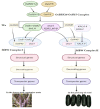Recent Insights into Anthocyanin Pigmentation, Synthesis, Trafficking, and Regulatory Mechanisms in Rice (Oryza sativa L.) Caryopsis
- PMID: 33800105
- PMCID: PMC8001509
- DOI: 10.3390/biom11030394
Recent Insights into Anthocyanin Pigmentation, Synthesis, Trafficking, and Regulatory Mechanisms in Rice (Oryza sativa L.) Caryopsis
Abstract
Anthocyanins are antioxidants used as natural colorants and are beneficial to human health. Anthocyanins contribute to reactive oxygen species detoxification and sustain plant growth and development under different environmental stresses. They are phenolic compounds that are broadly distributed in nature and are responsible for a wide range of attractive coloration in many plant organs. Anthocyanins are found in various parts of plants such as flowers, leaves, stems, shoots, and grains. Considering their nutritional and health attributes, anthocyanin-enriched rice or pigmented rice cultivars are a possible alternative to reduce malnutrition around the globe. Anthocyanin biosynthesis and storage in rice are complex processes in which several structural and regulatory genes are involved. In recent years, significant progress has been achieved in the molecular and genetic mechanism of anthocyanins, and their synthesis is of great interest to researchers and the scientific community. However, limited studies have reported anthocyanin synthesis, transportation, and environmental conditions that can hinder anthocyanin production in rice. Rice is a staple food around the globe, and further research on anthocyanin in rice warrants more attention. In this review, metabolic and pre-biotic activities, the underlying transportation, and storage mechanisms of anthocyanins in rice are discussed in detail. This review provides potential information for the food industry and clues for rice breeding and genetic engineering of rice.
Keywords: MBW complex; anthocyanin; anthocyanin vacuolar intrusion; antioxidant; black rice; cyanidin-3-glucoside; transcription factor; transporters.
Conflict of interest statement
The authors declare no conflict of interest.
Figures





References
-
- Hou Z., Qin P., Zhang Y., Cui S., Ren G. Identification of anthocyanins isolated from black rice (Oryza sativa L.) and their degradation kinetics. Food Res. Int. 2013;50:691–697. doi: 10.1016/j.foodres.2011.07.037. - DOI
-
- Kocic B., Filipovic S., Nikolic M., Petrovic B. Effects of anthocyanins and anthocyanin-rich extracts on the risk for cancers of the gastrointestinal tract. Off. J. Balk. Union Oncol. 2011;16:602–608. - PubMed
Publication types
MeSH terms
Substances
LinkOut - more resources
Full Text Sources
Other Literature Sources

